

Quarterly Publication of Individuals Who Have Chosen to Expatriate - Wikipedia. The Quarterly Publication of Individuals Who Have Chosen to Expatriate, also known as the Quarterly Publication of Individuals, Who Have Chosen to Expatriate, As Required by Section 6039G, is a publication of the United States Internal Revenue Service (IRS) in the Federal Register, listing the names of certain individuals with respect to whom the IRS has received information regarding loss of citizenship during the preceding quarter.
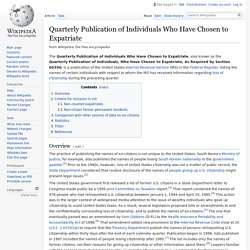
Overview[edit] The United States government first released a list of former U.S. citizens in a State Department letter to Congress made public by a 1995 Joint Committee on Taxation report.[3] That report contained the names of 978 people who had relinquished U.S. citizenship between January 1, 1994 and April 25, 1995.[4] This action was in the larger context of widespread media attention to the issue of wealthy individuals who gave up citizenship to avoid United States taxes. Criteria for inclusion in list[edit] Non-covered expatriates[edit] Statistics[edit] GPO-CPRT-JCS-2-03-14-10. The 1904 World's Fair: A Turning Point for American Food. [Photograph: Library of Congress] If you believe the popular tales, more new American foods were invented at the 1904 World's Fair in St.

Louis, Missouri, than during any other single event in history. The list includes the hamburger, the hot dog, peanut butter, iced tea, the club sandwich, cotton candy, and the ice cream cone, to name just a few. If all the pop histories and internet stories have it right, American foodways would be almost unrecognizable if the 1904 fair had not been held. And what dramatic stories they are. These stories are all quite precious, but they're also pretty easy to debunk. But I think there's a reason that so many of these tall tales have been rooted in a single place and point in time.
'Living Exhibits' at 1904 World's Fair Revisited. Palace of Electricity and Palace of Varied Industries from the Cascade Gardens. 1904 Gold Medal Series. Mr. Jack Daniel's trip to the 1904 St. Louis World fair. Pharus-map World's Fair St. Louis, 1904. Rights assessment is your responsibility.
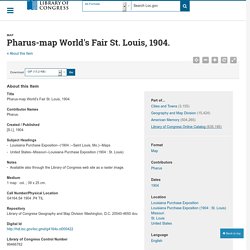
The maps in the Map Collections materials were either published prior to 1922, produced by the United States government, or both (see catalogue records that accompany each map for information regarding date of publication and source). The Library of Congress is providing access to these materials for educational and research purposes and is not aware of any U.S. copyright protection (see Title 17 of the United States Code) or any other restrictions in the Map Collection materials.
Note that the written permission of the copyright owners and/or other rights holders (such as publicity and/or privacy rights) is required for distribution, reproduction, or other use of protected items beyond that allowed by fair use or other statutory exemptions. Responsibility for making an independent legal assessment of an item and securing any necessary permissions ultimately rests with persons desiring to use the item. More about Copyright and other Restrictions. Relics of the World's Fair: St. Louis - Atlas Obscura. Louisiana Purchase Festival Hall (via Wikimedia) After visiting Paris, Chicago, Barcelona, New York City, and Montreal, Atlas Obscura’s tour of World’s Fair relics stops in St.
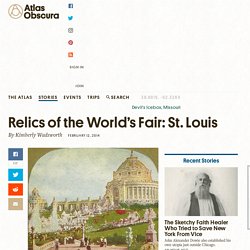
Louis, Missouri. 1904 World's Fair: Looking Back at Looking Forward. He story behind the construction of the 1904 World’s Fair is one of human perseverance—a testimony to the energy, investment, and commitment of St.
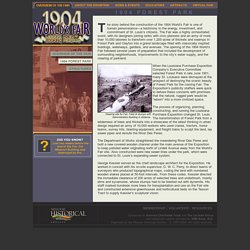
Louis’s citizens. The Fair was a highly orchestrated event, with its designers joining ranks with civic planners and an army of more than 10,000 laborers to transform over 1,200 acres of thickets and swamps in Forest Park and Clayton into a grand landscape filled with classically inspired buildings, waterways, gardens, and avenues. The 1904 World's Fair: A Turning Point for American Food. Grand Entrance to the German Exhibit, a magnificent color-scheme in marble and bronze. Mr. Jack Daniel's trip to the 1904 St. Louis World fair. The Virginia Center for Digital History at The University of Virginia.
VCDH News… for the latest press releases and information on VCDH projects… July 2009 -- Charlottesville City, Albemarle County, Greene County, Madison County, and Orange County Public Schools, in partnership with the Virginia Center for Digital History, have been awarded a Teaching American History grant by the U.S.
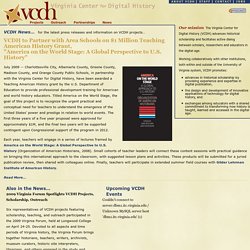
Department of Education to provide professional development training for American and world history educators. Titled America on the World Stage, the goal of this project is to recognize the urgent practical and conceptual need for teachers to understand the emergence of the United States' power and prestige in relation to world events. The first three years of a five year proposal were approved for approximately $1M, and the final two years will be supported contingent upon Congressional support of the program in 2012. Each year, teachers will engage in a series of lectures framed by America on the World Stage: A Global Perspective to U.S.
Read More… The Tao of History – Engaging in online public discourse about digital history. 17 Best images about Women's History Month (HERSTORY MONTH) on Pinterest.